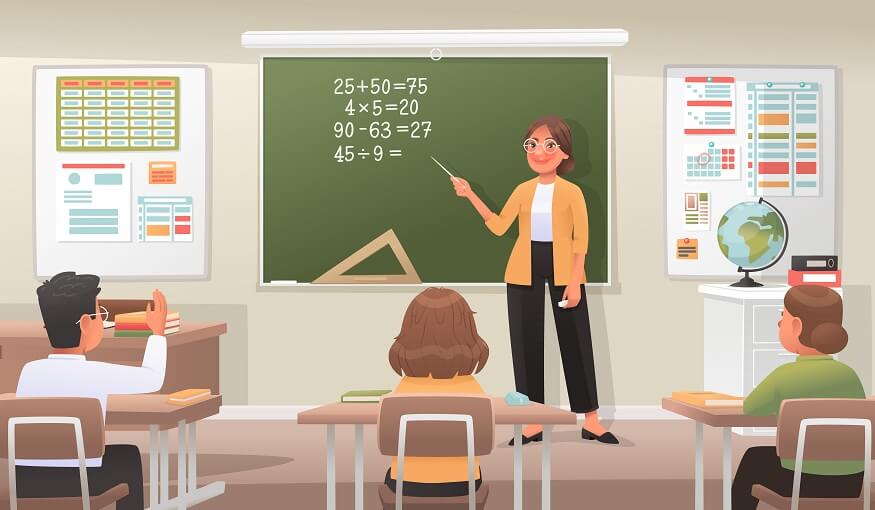Classroom management is not about having the right rules. It is about having the right relationship with the students. A teacher has so many skills, but among all of them, having classroom management techniques tops the list. Classroom management is important because without discipline and disruption, neither the educator will be able to teach properly, nor the students will understand efficiently. Classroom management is non-negotiable in the teaching-learning process. An educator must keep some classroom management strategies handy to implement them while teaching.
Proper management of the classroom by teachers is the process of focusing on a positive learning environment for children that is conducive to effective teaching and learning experiences. It is one of the most important aspects of teaching that ensures students are occupied, influenced, and engrossed in learning. Effective classroom management strategies and techniques help teachers create a safe, supportive environment that promotes students’ achievement and success.
Effective classroom management is crucial for creating a positive and productive learning environment. It involves a combination of effective classroom management strategies and techniques that enable teachers to establish and maintain a safe, supportive, and engaging classroom atmosphere.
Also read : Best Assessment for Learning Strategies and How to Make Them Work in Your Classroom
Some of the benefits of classroom management strategies are:
- Promotes a positive learning environment A well-managed classroom creates a positive and supportive learning environment that promotes academic and personal growth. Students are more likely to engage in class and participate in activities when they feel safe, respected, and valued.
- Improves student achievement Effective classroom management can improve student achievement and academic performance. By creating a structured and engaging learning environment, teachers can help students develop the skills and knowledge necessary to succeed academically.
- Reduces classroom disruptions Effective classroom management helps reduce classroom disruptions that can negatively impact student learning. By setting clear expectations and rules, teachers can establish a predictable and structured classroom environment that minimises distractions and disruptions.
- Fosters positive relationships Effective classroom management strategies can foster positive relationships between teachers and students. By establishing a positive classroom culture and using positive reinforcement, teachers can build trust and respect with their students.
- Promotes student engagement Students are more likely to be successful in school and beyond if they are engaged and busy with relevant activities and learning experiences. Classroom management can promote student engagement by creating a structured and engaging learning environment that encourages active participation and fosters a love for learning.
Also read : How To Support Children with Autism in The Classroom
Here are some effective classroom management strategies for new teachers as well as experienced educators.
- Outline clear expectations and rules Classroom management strategies like this one aim to establish clear expectations and rules for behaviour. Educators and facilitators must generate a list of classroom rules that are easy to understand and enforce. There could be rules pertaining to behavioural expectations, communication instructions, evaluation expectations, and other similar rules and regulations. Such regulations must be posted in an accessible location in the classroom surroundings, and students should be reminded of them frequently and reprimanded if necessary. Facilitators must also outline clear expectations with respect to student behaviour and work ethic. This includes expectations for participation, completion of assignments, and overall conduct in the classroom.
- Enforce positive reinforcement Positive reinforcement is a powerful tool for encouraging positive behaviour in the classroom. This is one of the most effective classroom management strategies. Teachers should praise and reward students who demonstrate positive behaviour and work ethic. This can be done through verbal praise, stickers, or other rewards. It is important to note that positive reinforcement should be used consistently and fairly. Facilitators should avoid favouritism and ensure that all students have the same opportunity as the next child to receive praise and rewards.
- Utilise discipline strategies Discipline is an essential part of classroom management; however, it is important to use effective discipline strategies that are fair and consistent. This is one of the classroom management strategies that educators should be careful about. Teachers should avoid using punishment as a form of discipline and instead focus on corrective action. Effective discipline strategies include verbal warnings, timeouts, and logical consequences. Teachers should also be willing to work with students to develop a plan for improving their behaviour.
- Employ effective communication Effective communication is critical to successful classroom management. Teachers should communicate clearly and respectfully with students, parents, and other teachers. This includes using positive language and avoiding negative language. Teachers should also actively listen to students to be responsive to their needs and concerns. This can help build trust and create a positive learning environment.
- Developing a positive classroom culture Creating a positive classroom culture is an important aspect of classroom management. This is one of the crucial classroom management techniques. Facilitators must try to encourage a classroom situation that instils positive behaviour. This can be done through a variety of strategies, including building positive relationships with students, encouraging collaboration and teamwork, celebrating student successes and compliments, and providing opportunities for student input and decision-making. By creating a positive classroom culture, teachers can help students feel valued and motivated to learn.
- Use technology to support classroom management Technology can be a useful tool for classroom management. In today’s era, technology acts as one of the most important classroom management techniques. Teachers can use online tools and resources to help manage classroom tasks, communicate with students and parents, and track student progress. For example, teachers can use online grade books to track students’ grades and assignments. They can also use online tools to create and manage classroom assignments and projects.
Also read : How to Develop Grit in Students – 10 Tips
These are some effective classroom management strategies for new teachers as well as experienced educators. Teaching professionals can take heed of these tips to develop their classroom management skills. EuroSchool has been giving importance to classroom management strategies and techniques since the beginning. Our professionals and teachers are trained to manage a class with activities and strategies to engage students. We consider classroom management to be crucial for an educator’s skill set.









